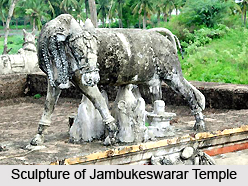 As per the legend Goddess Parvati mocked Lord Shiva`s penance. He tried to condemn her act and directed her to go to the earth from `Kailayam` and do penance. Goddess Parvathi as per Shiva`s wish found `Jambu` forest to conduct her penance. Devi cretaed a Lingam out of water of river Kaveri under the `Venn Naaval` tree and commenced her worship. The Lingam is known as `Appu Lingam` or Water Lingam. Lord Siva at last gave darshan to her and taught her Siva Gnana. She took lessons facing east from Shiva who stood facing west. As the Devi was like a student and the Lord like a Guru in this temple, there is no marriage conducted in this temple for Lord & the Devi.
As per the legend Goddess Parvati mocked Lord Shiva`s penance. He tried to condemn her act and directed her to go to the earth from `Kailayam` and do penance. Goddess Parvathi as per Shiva`s wish found `Jambu` forest to conduct her penance. Devi cretaed a Lingam out of water of river Kaveri under the `Venn Naaval` tree and commenced her worship. The Lingam is known as `Appu Lingam` or Water Lingam. Lord Siva at last gave darshan to her and taught her Siva Gnana. She took lessons facing east from Shiva who stood facing west. As the Devi was like a student and the Lord like a Guru in this temple, there is no marriage conducted in this temple for Lord & the Devi.
Legend of the Name - `Thiru Aanai Kaa`
There were two Siva Ganas called `Malyavan` and `Pushpadanta`. They always quarrelled with each other and fight for one thing or other despite being Shiva ganas. In one fight `Malyavan` cursed `Pushpadanta` to become an elephant on earth and the latter cursed him to become a spider on earth. The elephant and the spider came to Jambukeshwaram and continued their Shiva worship. The elephant collected water from river Kaveri and conducted Abhishekam to the lingam under Jambu tree. The spider constructed his web over the lingam in order to prevent dry leaves from dropping on it and prevent sunlight directly falling on Shiva. When the elephant saw the web he thought it to be dust on Lord Shiva and tore them and cleaned it by pouring water. This happened daily. The spider got angry and crawled into the trunk of the elephant and bit the elephant to death killing itself. Lord Siva relieved them from one other curse. As an elephant worshipped the Lord here, this place was known as `Thiru Aanai Kaa`. Later on the actual name `Thiruaanaikaa` become `Thiruvanaikaval` and `Thiruvanaikoil`.
In the next birth the Spider was born as the King Kochengot Chola and built 70 temples and Thiruvanaikoil is the one of them. He built the Lord Shiva `Sannathi` in such a way that not even a small elephant can enter. The entrance is only 4 foot high and 2.5 foot wide.
This article is a stub. You can enrich by adding more information to it. Send your Write Up to [email protected]





















